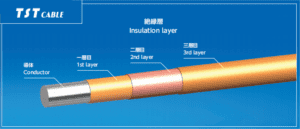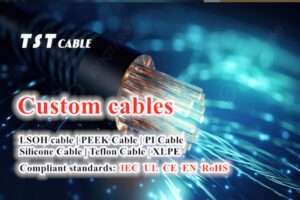- Home
- /
- Marine instrumentation equipment
Application of Marine instrumentation equipment cable | TST CABLES
1.Scene Introduction
With the continuous improvement of ship automation and intelligence level, marine instrumentation equipment plays an increasingly important role in ship navigation, cargo handling, safety management and other aspects. As a key component connecting instrumentation equipment and control system, the performance and quality of marine instrumentation cable is directly related to the accuracy and reliability of instrumentation equipment. Currently, the marine instrumentation cable market is facing the dual opportunities of technological upgrading and market demand growth.
2.The pain point analysis
Although marine instrumentation cables play an important role in the marine industry, there are still many pain points in existing products:
Unstable electrical performance: some cables in the transmission of instrumentation signals there are distortions, delays and other problems, affecting the measurement accuracy of instrumentation equipment.
Weak anti-interference ability: electromagnetic interference in the ship’s operating environment is serious, the anti-interference ability of traditional cables is insufficient, which can easily lead to instrumentation equipment malfunction.
Poor environmental adaptability: the ship’s working environment is complex and changeable, the performance of traditional cables in harsh environments attenuate faster, the use of short life.
Certification standards are not uniform: marine instrumentation equipment on the market a wide range of cable certification standards, resulting in users in the selection of difficult to choose.
3.The marine instrumentation equipment on the cable requirements
For the above pain points, marine instrumentation equipment on the cable put forward the following requirements:
Excellent electrical performance: the cable should have high transmission efficiency, low attenuation, low noise and other characteristics to ensure accurate transmission of instrumentation signals.
Strong anti-interference ability: the cable should have good electromagnetic shielding performance, effectively resist external electromagnetic interference.
Good environmental adaptability: the cable should have excellent temperature resistance, humidity resistance, salt spray resistance and other properties, adapt to a variety of harsh working environments on board.
Compliance with certification standards: the cable should comply with the relevant international and domestic certification standards to ensure product quality and safety.
4.Marine instrumentation equipment cable certification standards
Marine instrumentation equipment cables need to comply with a series of international and domestic certification standards to ensure that their quality and performance to meet industry requirements. The main certification standards, including the International Electrotechnical Commission (IEC) developed by the relevant cable standards, classification societies (such as DNV GL, ABS, LR, etc.) certification specifications, as well as specific national and regional standards. These standards on the electrical performance of the cable, mechanical properties, environmental adaptability, fire safety and other aspects of strict regulations to ensure the safe and reliable operation of the cable in the ship instrumentation equipment.
5.Cable selection
In the selection process of marine instrumentation equipment cable, TST CABLES suggests to consider the performance parameters of the cable, the working environment, certification standards and cost and other factors. First of all, according to the electrical characteristics of the instrumentation equipment and signal transmission requirements, select the appropriate conductor cross-sectional area, insulation materials and shielding structure of the cable. Secondly, it is necessary to consider the performance of the cable in the working environment of the ship in terms of temperature resistance, humidity resistance, salt spray resistance, etc., to ensure that the cable can work stably for a long time. In addition, it is also necessary to select cable products that meet the relevant certification standards to ensure their quality and safety.
6.Product characteristics
The marine instrumentation equipment cables provided by this solution have the following remarkable characteristics:
Excellent electrical performance: high purity copper conductor and high quality insulation materials are used to ensure efficient and accurate signal transmission.
Strong anti-interference ability: the cable adopts multi-layer shielding structure to effectively resist electromagnetic interference and ensure the stable operation of instrumentation equipment.
Good environmental adaptability: the outer sheath of the cable is made of special materials with excellent temperature, humidity and salt spray resistance, adapting to a variety of harsh working environments.
Safe and reliable: the cable meets the relevant certification standards, with fire prevention, low smoke and halogen-free and other safety features to ensure the safe operation of the ship.
Recommended Products
TST marine cables are durable, waterproof, high-temperature resistant, interference-resistant, flame retardant, environmentally friendly, and have excellent insulation properties. They can ensure stable operation of cables in harsh marine working environments.
7.Technical Test
In order to ensure the performance and quality of marine instrumentation equipment cables, TST CABLES has conducted a series of strict technical tests. These tests include electrical performance tests (e.g., transmission efficiency, attenuation, noise, etc.), mechanical performance tests (e.g., tensile strength, bending performance, etc.), environmental adaptation tests (e.g., resistance to temperature, humidity, salt spray, etc.), and fire safety tests. The test results show that the marine instrumentation cable of this solution fully meets the requirements of marine instrumentation equipment.
8.Marine instrumentation equipment cable laying installation and commissioning
In the process of cable laying, installation and commissioning of marine instrumentation equipment, TST CABLES follows the professional operation standard to ensure that the cable is smooth and damage-free. First of all, according to the layout and working environment of marine instrumentation equipment, develop a reasonable cable laying program. During the laying process, special laying equipment and tools are used to avoid excessive stretching or bending of the cable. After the installation is completed, carry out the debugging and testing of the cable to ensure that its connection with the control system is stable and reliable, and the signal transmission is accurate.
9.After-sales maintenance & technical support
TST CABLES provides comprehensive after-sales maintenance and technical support services for marine instrumentation equipment cables. Once customers encounter any problems in the use process, our professional team will respond quickly to provide effective solutions and technical support. In addition, we also regularly provide customers with cable product maintenance and maintenance recommendations to ensure the long-term stable operation of the cable.
10.Marine instrumentation equipment cable program case
A medium-sized cargo ship decided to fully replace its instrumentation equipment cables when modernizing and upgrading. Considering that the ship often sails in complex marine environments and needs to run stably for a long period of time, the cargo ship has very high requirements for the electrical performance, environmental adaptability and safety of the cables.
TST CABLES has customized a set of marine instrumentation cable solution for the specific needs of this cargo ship. The cable adopts high-quality copper conductor to ensure the high efficiency and accuracy of signal transmission; the insulating material is made of high-temperature-resistant and corrosion-resistant special material to adapt to the special requirements of the marine environment; and the outer layer of the cable adopts a multi-layer shielding structure, which can effectively resist electromagnetic interference and ensure the stable operation of instrumentation equipment.
Cargo ship owners are very satisfied with the implementation effect of this marine instrumentation equipment cable program. They said that the new cable not only improves the performance of instrumentation equipment, but also improves the overall safety and reliability of the ship. The ship owner also highly praised the professional service and technical support of TST CABLES, and indicated that they would continue to cooperate with us to jointly promote the ship modernization and upgrading process.
Other solutions for cables in marine applications.
WHY CHOOSE TST
10 years of experience
Specializing in the production of railway cables for 10 years
Engineer-to-engineer one-on-one support
Engineers provide one-on-one service to assist with product selection and problem-solving
Customization according to requirements
With a strong R&D team, we support customized cables based on specific needs
Quality certification
Stringent adherence to industry standards, complete certification
Fully testing facilities
Various tests based on customer requirements
10,000 ㎡ factory
Welcome to visit our factory face to face
RELATER NEWS
Also available in:
Arabic
English
German
Indonesian
Japanese
Russian
Spanish
Thai
Vietnamese
Portuguese (Brazil)




